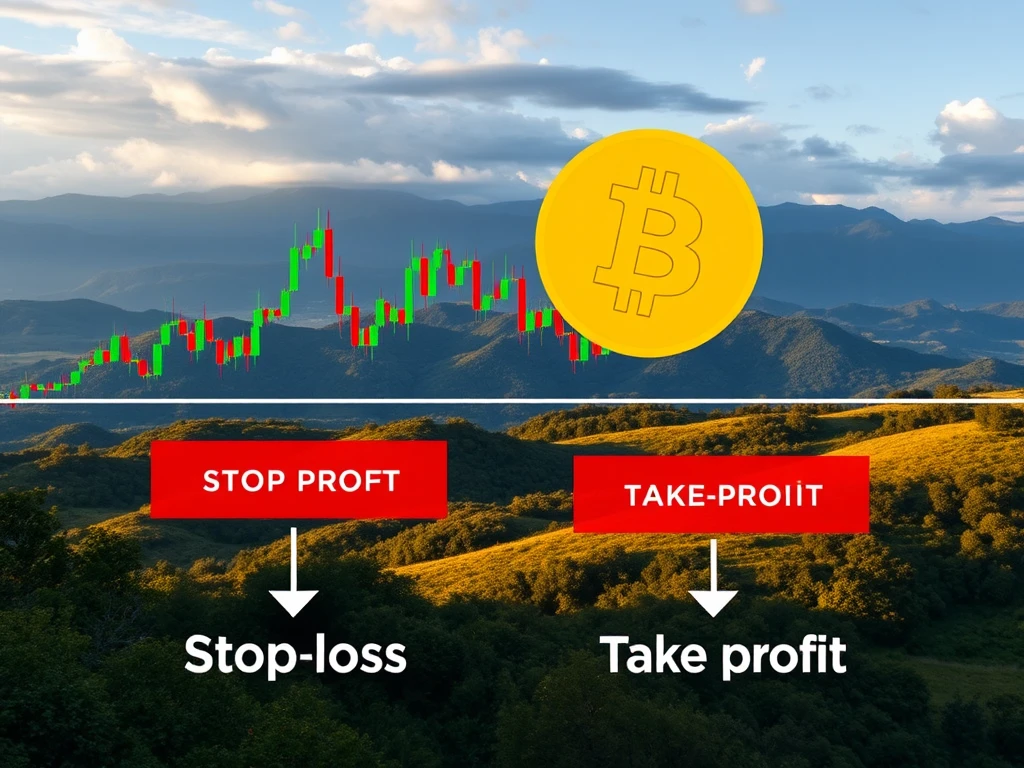Bitcoin Trading: Essential Guide to Stop-Loss & Take-Profit Orders

Navigating the fast-paced, 24/7 world of crypto can feel overwhelming. The price of Bitcoin moves quickly, presenting both opportunities and risks. This is where smart tools become essential for successful Bitcoin trading. Automated orders like stop-loss and take-profit are designed to help you manage your positions effectively, even when you can’t constantly monitor the market.
Understanding Stop-Loss and Take-Profit
At their core, a stop loss and a take profit order are automated instructions you give your trading platform. They tell the system to close your position once a specific price level is reached. Think of them as predefined exit points for your trade.
- A stop-loss order is set below your entry price (for a long position) or above your entry price (for a short position). Its primary goal is to limit your potential loss if the market moves against you.
- A take-profit order is set above your entry price (for a long position) or below your entry price (for a short position). Its purpose is to automatically secure your gains when the market reaches your target price.
Using these orders helps remove emotion from trading decisions. This disciplined approach is a fundamental part of any sound crypto trading strategy.
Why These Orders Matter for Bitcoin Trading
Bitcoin’s market is known for its significant price swings. While volatility can mean profit potential, it also brings considerable risk. Implementing a solid risk management plan is crucial, and stop-loss and take-profit orders are key components.
Consider these points:
- Volatility Control: Bitcoin prices can change dramatically in short periods. A stop loss caps your downside risk during sudden drops or flash crashes. A take profit ensures you capture gains during quick upward moves before a potential reversal.
- 24/7 Market: The crypto market never sleeps. You can’t watch charts around the clock. Automated orders protect your positions while you’re away, whether sleeping or at work.
- Emotional Discipline: Fear and greed can lead to poor trading decisions, like panic selling during a dip or holding onto a winning trade too long, only to see profits vanish. Setting predefined exit points helps you stick to your plan.
How to Set Up Stop-Loss and Take-Profit Orders
Setting up these orders varies slightly between platforms, but the general process is similar. Here’s a basic guide:
- Choose Your Platform: Select a reliable exchange with the features you need. Consider fees, liquidity, and security.
- Open a Position: Decide on your trade (buy or sell Bitcoin) and the amount.
- Locate Order Options: On the trading interface, look for options to set ‘Stop Loss’ and ‘Take Profit’ when placing or managing your order.
- Define Your Stop Loss: Based on your risk tolerance and analysis, enter the price level where you want to exit to limit losses. For example, if you buy BTC at $90,000 and set a stop loss at $85,000, the platform will sell your BTC if the price drops to $85,000.
- Define Your Take Profit: Based on your profit target, enter the price level where you want to exit to secure gains. If you buy BTC at $90,000 and set a take profit at $95,000, the platform will sell your BTC if the price reaches $95,000.
- Confirm and Monitor: Review your order details carefully before submitting. Once active, monitor the market and be prepared to adjust your orders if conditions change.
Best Practices for Stop-Loss Placement
Effective stop-loss placement is key to capital preservation. Consider these strategies:
- Based on Volatility: Use indicators like Average True Range (ATR) to place your stop loss a calculated distance away from your entry, accounting for typical price movement.
- Below Support Levels: Identify historical price levels where Bitcoin has found buying support. Placing your stop loss just below a key support level can help you avoid being stopped out by minor dips while protecting against a major breakdown.
- Avoid Obvious Levels: Round numbers ($80,000, $90,000) or easily identifiable chart patterns often attract concentrated stop orders. Placing your stop slightly below or above these levels can help avoid ‘stop hunting’.
- Trailing Stop Loss: Some platforms offer trailing stops, which automatically adjust the stop-loss price upward as the market moves favorably, helping to lock in profits while still limiting downside risk.
Best Practices for Take-Profit Placement
Strategic take-profit placement helps maximize your gains while preventing profits from evaporating.
- Align with Resistance: Set your take profit near historical resistance levels where selling pressure has previously appeared.
- Consider Momentum: If the market is showing strong upward momentum, you might consider extending your take-profit target to capture more of the move.
- Partial Profits: Instead of selling your entire position at one take-profit level, you can set multiple take-profit orders at different price targets to secure gains incrementally as the price rises.
- Adjust After Pullbacks: If your take profit was just missed and the price pulls back, you might reset your take-profit order to a slightly lower level for a potential smaller win on the next move up.
Adjusting Your Orders
Market conditions change, and so should your orders. Learning when and how to adjust your stop loss and take profit is part of refining your crypto trading strategy.
- Tighten Stop Loss: If the price moves significantly in your favor, move your stop loss up to reduce risk or even guarantee a profit (moving it above your entry price).
- Extend Take Profit: During strong trends or breakouts, you might raise your take-profit target to capture more upside.
- Widen Orders: Before major news events known to cause volatility, you might widen your stop loss or take profit slightly to avoid being stopped out prematurely by noise.
Most platforms allow you to easily modify open orders through a ‘modify position’ or ‘edit trade’ option.
Avoiding Common Mistakes
Even with these tools, mistakes happen. Here’s how to avoid mistakes when using stop-loss and take-profit orders in Bitcoin trading:
- Stops Too Tight: Setting your stop loss too close to your entry price increases the chance of being stopped out by normal market fluctuations. Use volatility metrics to set appropriate distances.
- Ignoring Slippage: In volatile or low-liquidity conditions, your order might not execute at the exact price you set. It could ‘slip’ to a worse price. Be aware of this possibility, especially with stop-loss orders during crashes.
- Chasing Round Numbers: As mentioned, placing orders exactly at round numbers can make you a target for other traders or bots.
- Forgetting to Adjust: Static orders in a dynamic market can lead to missed opportunities or unnecessary losses. Regularly review and adjust your orders based on current market conditions. Use platform alerts to stay informed.
- Misjudging Market Context: Don’t set tight stops in highly volatile periods or wide take profits in clear downtrends. Your order strategy must align with the prevailing market sentiment and structure.
- Not Accounting for Fees: Trading fees can impact your profitability, especially on smaller gains or with frequent trades. Factor fees into your profit targets.
- Panic Canceling: Stick to your plan. Canceling orders impulsively due to short-term price movements, especially during temporary dips, can be detrimental. Trailing stops can help automate adjustments without panic.
Conclusion: Essential Tools for Risk Management
Stop-loss and take-profit orders are fundamental tools for any serious Bitcoin trading enthusiast. They provide a structured approach to managing risk and securing profits automatically. By understanding how to set them up, implementing best practices for placement, and avoiding common mistakes, you can navigate the volatile crypto market with greater discipline and confidence. These tools are not guarantees of profit, but they are vital for protecting your capital and executing your crypto trading strategy effectively. Always test strategies in a demo environment before trading live funds.
This article does not contain investment advice or recommendations. Every investment and trading move involves risk, and readers should conduct their own research when making a decision.









